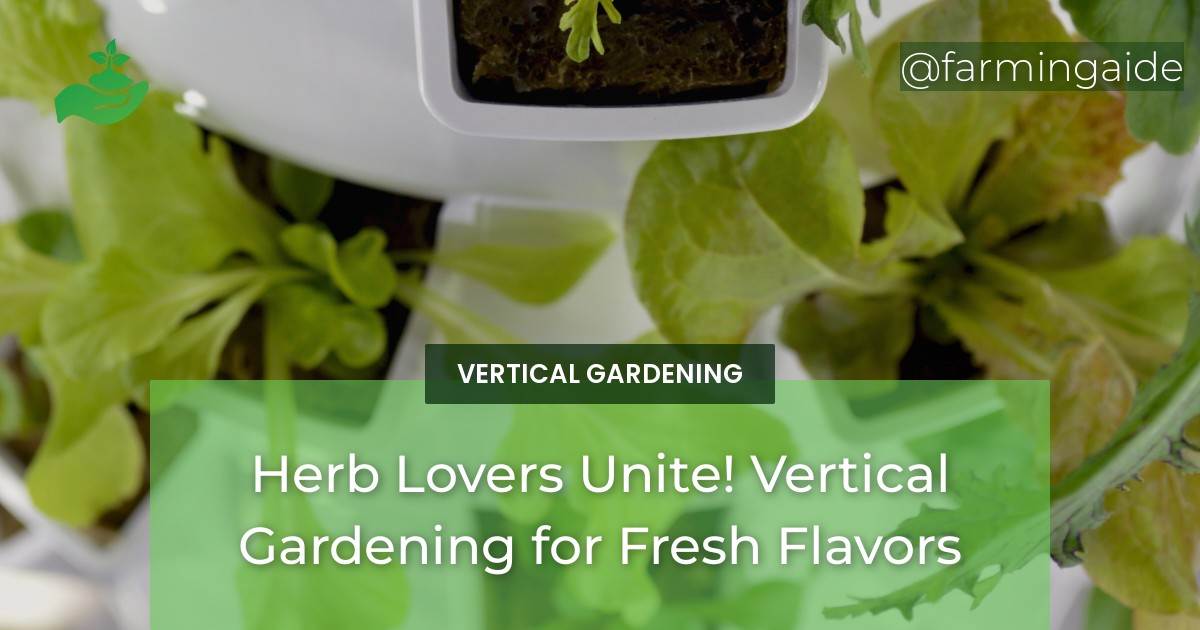Are you a lover of fresh and flavorful herbs? Have you always wanted to grow your own herbs but lack the space for a traditional garden? Well, fear not!
Vertical gardening for herbs is the perfect solution for herb enthusiasts who are short on space but still want to enjoy the taste and aroma of fresh herbs straight from their own garden.
Table of Contents
Advantages of Growing Herbs Vertically
Vertical gardening for herbs has many advantages over traditional gardening, including:
- Space-saving: Vertical gardens take up minimal space and can even be grown indoors, making them perfect for small apartments or balconies.
- Easy maintenance: Vertical gardens require less weeding and watering than traditional gardens, and because they are raised off the ground, they are less susceptible to pests and diseases.
- Improved air circulation: Because vertical gardens are raised off the ground, air can circulate freely around the plants, preventing the growth of mold and mildew.
- Pest control: Vertical gardens are less accessible to pests and animals, reducing the need for pesticides and other chemicals.
- Aesthetic appeal: Vertical gardens are visually stunning and can be designed to complement any decor.
Best Herbs for Vertical Gardens
Many herbs thrive in a vertical garden environment, including:
- Basil: This fragrant herb is perfect for adding flavor to salads, pasta dishes, and more.
- Thyme: Thyme is a versatile herb that can be used to flavor everything from roasted vegetables to grilled meats.
- Mint: Mint is a refreshing herb that is perfect for adding flavor to summer drinks, desserts, and more.
- Sage: This savory herb is perfect for seasoning poultry, pork, and other meats.
- Oregano: Oregano is a fragrant herb that is perfect for adding flavor to pizza, pasta, and other Italian dishes.
- Parsley: This mild herb is perfect for adding flavor to soups, stews, and other savory dishes.
- Cilantro: Cilantro is a popular herb in Mexican and Asian cuisine and is perfect for adding flavor to salsas, curries, and more.
- Rosemary: This fragrant herb is perfect for seasoning roasted potatoes, grilled meats, and more.
ALSO READ
Designing an Herb Wall
When designing an herb wall, there are several things to consider:
- Choosing the right location: Herbs require plenty of sunlight, so be sure to choose a location that gets at least six hours of direct sunlight per day.
- Selecting the right vertical garden system: There are many different types of vertical garden systems available, including wall-mounted planters, living walls, and more. Choose a system that fits your space and your needs.
- Preparing the wall: Before planting your herbs, be sure to prepare the wall by cleaning it and installing any necessary hardware.
- Planting the herbs: When planting your herbs, be sure to follow the instructions provided by the vertical garden system manufacturer.
- Maintaining the wall: Regular maintenance is key to keeping your herb wall healthy and thriving. Be sure to water your herbs regularly, prune them as needed, and keep an eye out for pests and diseases.
Harvesting and Preserving Herbs
Harvesting and preserving your herbs is easy and fun. Here are some tips:
- Understanding the best time to harvest: Herbs should be harvested when they are at their freshest and most flavorful. Generally, this means harvesting in the morning after the dew has dried.
- Techniques for harvesting: Different herbs require different harvesting techniques. Some herbs, like basil and mint, can be harvested by pinching off the leaves, while others, like rosemary and thyme, require a pair of sharp scissors.
- Drying herbs: Drying herbs is a great way to preserve them for later use. Simply tie a bunch of herbs together and hang them in a dry, well-ventilated area until they are dry and crispy.
- Storing herbs: Store your dried herbs in an airtight container in a cool, dark place to keep them fresh and flavorful for months to come.
ALSO READ
Using Herbs in Cooking and Teas
Herbs are incredibly versatile and can be used in a wide variety of dishes and teas. Here are some ideas:
- Ideas for using herbs in dishes: Herbs can be used to flavor everything from soups and stews to salads and sandwiches. Try adding some fresh herbs to your favorite dishes for a burst of flavor.
- Recipes for infused oils, vinegars, and butters: Infusing oils, vinegars, and butters with fresh herbs is a great way to add flavor to your cooking. Simply heat your oil, vinegar, or butter and add your herbs. Let the mixture cool and strain out the herbs before using.
- Making herb teas: Herbal teas are a great way to enjoy the flavor and health benefits of fresh herbs. Simply steep your herbs in hot water for a few minutes and enjoy.
Conclusion
Vertical gardening for herbs is a fun and rewarding way to enjoy fresh, flavorful herbs all year round. Whether you’re growing basil for your favorite pasta dish or thyme for your roasted vegetables, a vertical herb garden is a great way to bring fresh flavors to your kitchen. So why not give it a try? With a little planning and a lot of love, you can create a beautiful and bountiful herb wall that will provide you with fresh herbs for years to come.
RELATED ARTICLES:


